
Wild shima aji from Katsuyama in Chiba Prefecture, 700 g

A farmed shima aji for comparison. Fatter than the wild one.

1 With debabocho (broad-bladed kitchen knife), scrape off zengo (thorn-like scale) trying not to damage surface of silver skin.

Wild shima aji from Katsuyama in Chiba Prefecture, 700 g

A farmed shima aji for comparison. Fatter than the wild one.

1 With debabocho (broad-bladed kitchen knife), scrape off zengo (thorn-like scale) trying not to damage surface of silver skin.

2 Remove scales, scraping in reverse direction with tip of knife.

3 Cut off head behind pectoral fin.

4 Cut belly open up to anal fin and remove innards.

5 Rinse belly with water, and then insert knife above spine and cut open to root of tail.

6 Do the same for back side; slide knife above spine and slice half of flesh off of spine.

7 Place shima aji spine side down and insert knife along spine from back.

8 Then from belly, cut open along spine.

9 Hold knife with blade facing away and slice flesh off of spine to root of tail.

10 At root of tail, cut off flesh.

12 Switch to yanagiba (kitchen knife for sashimi) and carve out belly-bone while lightly pressing down with left fingers.

13 Remove bones and bones only, and none of the flesh.

14 Insert knife along impression of spine and separate belly portion.

15 Cut off red muscle and get back portion.

16 Chop off edge of tail side and start to peel skin from there. Insert knife in between skin and flesh and peel skin.

17 The flesh from the back and belly is called jomi.

The jomi of farmed shima aji: less translucent.

Mako garei from Joban, 1.5 kg

1 Comb out scales with yanagiba (kitchen knife for sashimi).
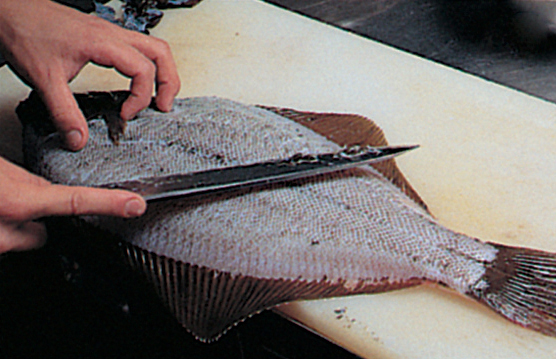
2 Slide knife carefully so as not to damage the flesh.

3 Do the same for white-skinned belly side.
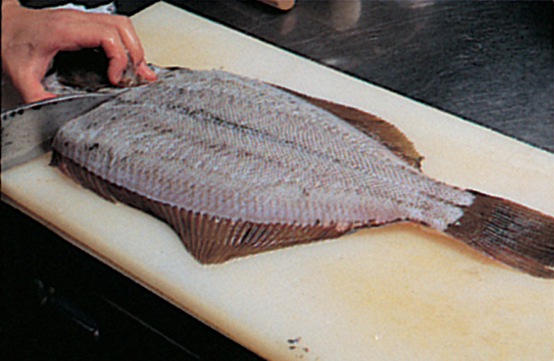
4 Raise pectoral fin, insert debabocho (broad-bladed kitchen knife), and cut off head.

5 Remove innards and insert knife along rib bones.

6 Scrape out red muscles located at backbone with tip of debabocho.

7 Slide knife along base of fin on the opposite side.

8 Lift up tail, hold knife with blade facing away, and slice along rib bones.

9 Likewise, with blading facing away, slice opposite side from tail toward head.

10 Insert knife to spine and slice along lateral line of fish.

11 Lifting up flesh from fin’s base, slice along rib bones with knife. Cut off and completely separate first fillet.

12 Insert knife along other side of spine.

14 With the bones facing down, make cut along base of both fins.

15 Cut down to spine.

16 Chop off tail at base.

17 Lifting up flesh, slice off third fillet.

18 Likewise, slice off fourth fillet.

19

20 Filleted into five pieces total, four of flesh and one with bones.

21 For each flesh piece, slice off engawa (root of fin) with yanagiba.

22 Comb out belly-bone carefully.
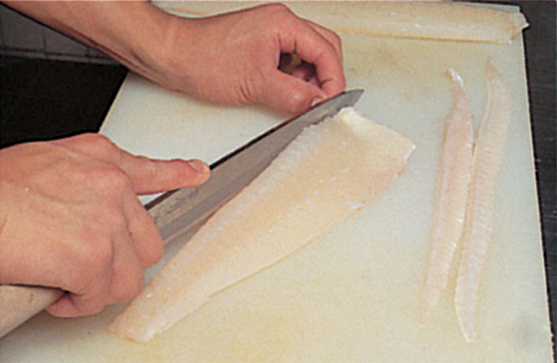
23 Chop off parts with strong sinews.
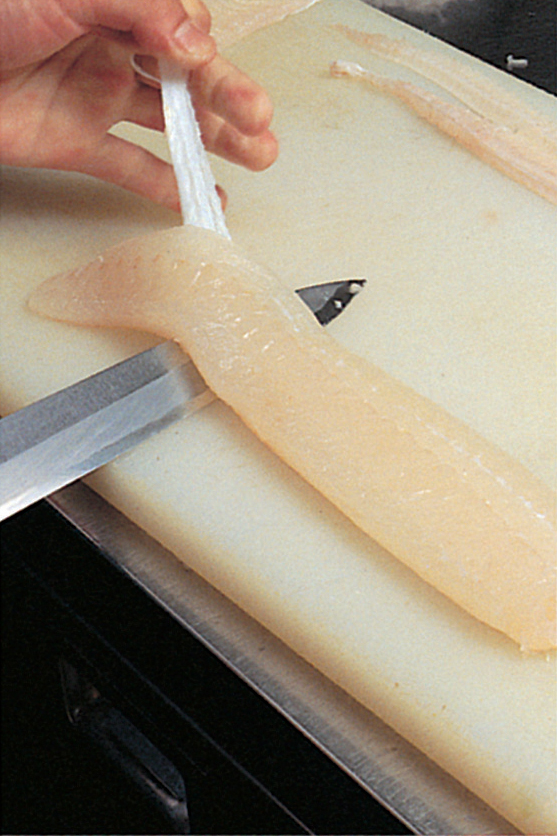
24 Peel a little bit of skin at tail. Pulling skin hard, insert knife between flesh and skin and peel as if pressing skin onto cutting board.

Kohada, from Kyushu, maruzuke-size

1 With debabocho (broad-bladed kitchen knife), raise fin and cut off at root.

2 Scrape off scales with tip of knife.

3 With the pectoral fin and behind the black dot as your guide, chop off head.

4 Chop off edge of belly right up to anal fin.

5 Push out innards using left thumb.

6 Chop off tail at root.
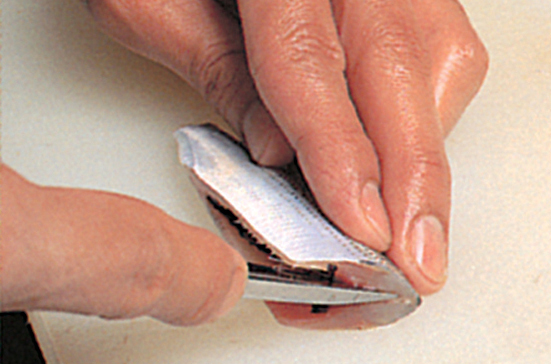
7 Insert knife above spine and slice toward tail in one go.

8 Insert knife between spine and flesh and slice off and separate flesh from spine.

9 Slice off belly-bone.
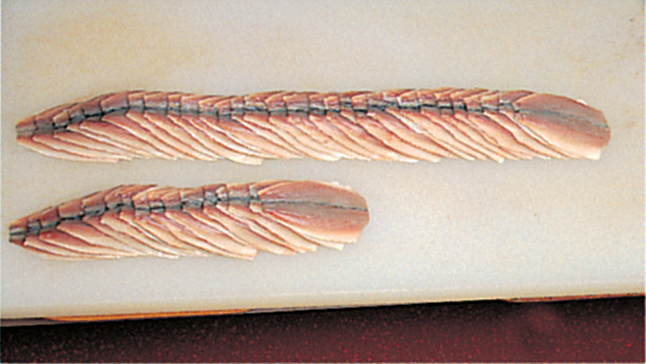
10 Sort by size, thickness, and fattiness.

11 Sprinkle salt on bonzaru (wicker colander).

12 Beginning with large kohada, arrange onto bonzaru skin-side down.

13 Sprinkle salt until kohada is slightly white.

15 Sprinkle them with salt, using less salt than for large kohada.

16 Let them rest for twenty-five minutes for large ones, twenty minutes for small ones.

17

18 Rinse both large and small ones and wash away the salt.

19 Place on zaru (wicker colander) and drain. Try not to mix small and large.

20 Rinse with vinegar once to wash away fishiness and sliminess, and put back on colander.
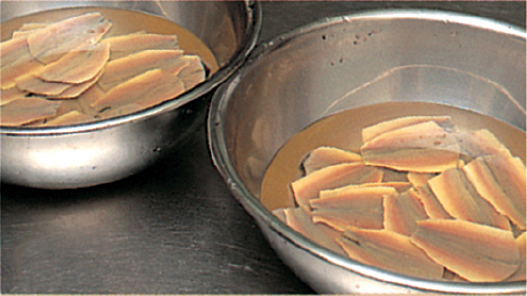
21 Soak large kohada in vinegar, and five minutes later put small kohada in another bowl of vinegar.

22 Flesh starts to turn white after twenty minutes.

23 Put each size into separate zaru and drain vinegar.

24 Stand them against colander, cover with plastic wrap, and let rest overnight in refrigerator.

25 Right after pickling and still raw.

26 Good to eat after a day

1 Soak shinko in salt water with ice cubes.
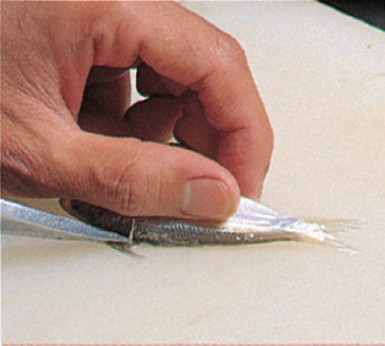
2 Cut dorsal fin and remove scales.
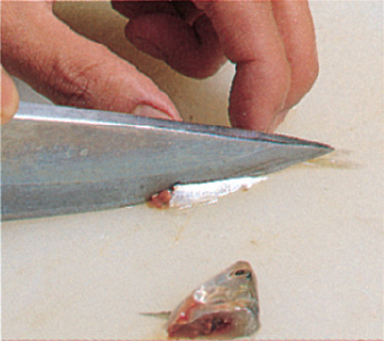
3 Chop off head and belly and remove innards.

4 Rinse with salt water with ice cubes to prevent flesh from becoming watery.

5 Slice along spine with knife and open flesh.
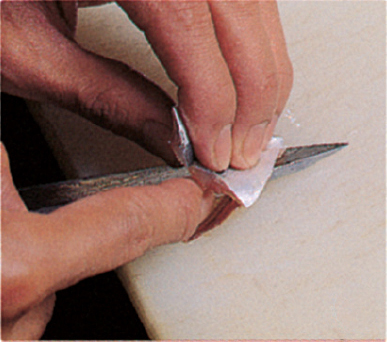
6 Insert knife between spine and flesh and slice off and separate flesh from spine.

7 Slice off belly-bone. Be careful not to take off too much since the flesh is thin.

8 Sort into three by size, thickness, and fat content.

9 Make three bowls of strongly salted water with ice cubes.

10 Soak pieces in salt water: big ones for four and a half minutes, medium for three minutes, small ones for two and a half minutes.

11 Put the shinko in colander and drain.

12 Rinse with vinegar by size.

13 Soak in vinegar: big ones for four and a half minutes, medium for three minutes, small ones for two minutes.

14 Drain vinegar and arrange shinko in colander, large ones first. Prepped in the morning, it’s good to eat by evening.

Maaji, fished aji from Futtsu, 120 g
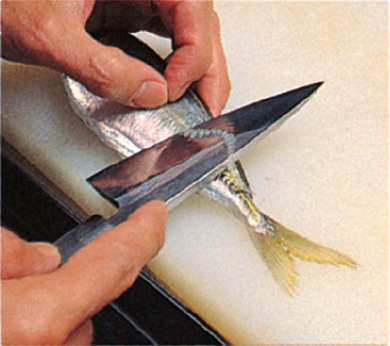
1 With debabocho (broad-bladed kitchen knife), slice off zengo (thorn like scale).

2 Remove scales with tip of knife.

3 Cut off head diagonally from behind pectoral fin.

4 Remove innards. With fresh ones, just pulling does it.

5 Scrape away any that’s left and rinse fish with water.

6

7 Insert knife by dorsal fin, slide knife along spine, and open flesh.

8

9 Slice along edge of dorsal fin with knife and cut off and separate flesh from spine.

10 Cut off spine at root of tail. Do not chop off tail yet.

11 Press down anal fin with knife, pull flesh, and extract entire bone.

12

13 Slice off belly-bone.

14 Chop off tail.

15 Follow impression of spine and remove small bones.

Masaba from Fukuoka, 800 g

1 Fillet saba into three.

2 Slice off belly-bone.

3 Place a bonzaru (wicker colander) on top of a bowl and arrange flesh of saba.

4 Sprinkle enough salt so you barely see the skin.

5 Flip and sprinkle lots of salt on flesh side as well.

6 Let sit for three hours, longer if they’re extra fatty.

7 Place saba in water and wash away salt.

8 Drain, placing saba on the colander.

9 Soak in vinegar chilled in the refrigerator.

10 The flesh turns white after soaking in vinegar for two and a half hours.

11 Take them out and drain vinegar on bonzaru.

12 Trace mark of spine and pluck small bones. Harder after flesh tightens.

13 Place belly side up in colander and cover with plastic wrap. Let rest in refrigerator overnight.

Maiwashi, large-sized iwashi from Nagai, 200 g

1 Scrape off scales with tip of debabocho (broad-bladed kitchen knife).

2 Cut off head diagonally from behind pectoral fin.

3 Chop off edge of belly right up to anal fin.

4 Scrape away innards and red muscle.

5 Cut off tail at root.
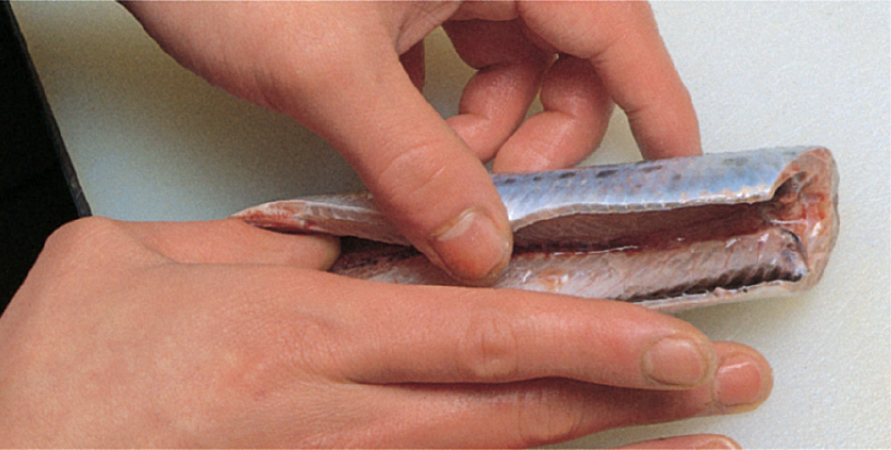
6 Insert thumb in belly and open fish to the tail.

7 Remove rib bones stuck in flesh as you carefully open it with your hands.

8 Pull up and raise spine and rib bones.

9 Pull spine and remove along with rib bones while trying not to damage flesh.

10 Slice off belly-bone.

11 Wipe red muscle away with cloth.

Sayori from Futtsu, 70 g

1 Scrape off scales with tip of debabocho (broad-bladed kitchen knife).
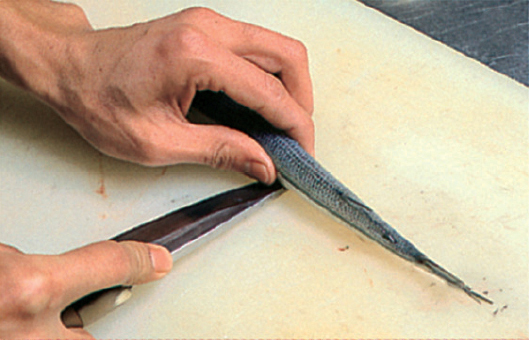
2 Extract belly fin while pressing down with knife.
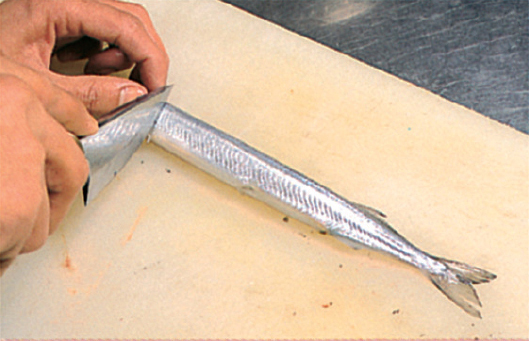
3 Cut off head behind pectoral fin.

4 Slice belly open up to anal fin.

5 Remove innards.

6 Insert knife along spine and slice open flesh.
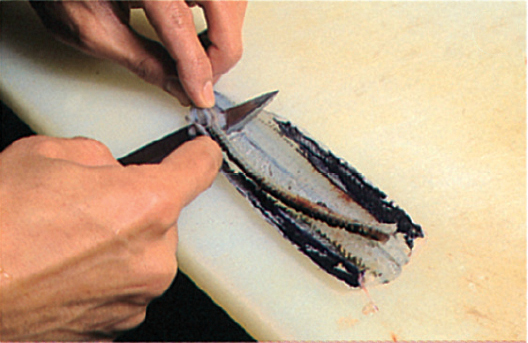
7 Slice off spine.

8 Slice off belly-bone as well.

9 Trace flesh with finger and make sure there are no small bones left.

10 Sprinkle salt lightly on both sides of sayori.

11 When flesh starts to sweat a little, rinse with water.

12 Drain on colander and put in refrigerator.

Live kuruma ebi, wild from Tokyo Bay, 50 g

1 Skewer from base of ebi’s legs.

2

3 Skewer straight in between shell and flesh up to tail so tail won’t bend.

4 Boil salt water and put ebi in it.

5 Cook for three and a half to four minutes.

6 Grab ebi and check to see if it’s cooked through by feeling its bounciness.

7

8 Blanch by chilling quickly in ice water to stop color from turning further.

9 Avoid chilling flesh too much, take out when it’s at around body temperature inside.

10 Remove skewer, rotating it. Bring ebi to counter.

Sumi ika from Nagasaki, 300 g

1 Remove pen by pushing it forward.
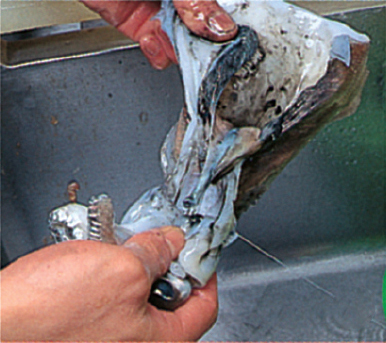
2 Open mantle and pull out tentacles.

3 Rinse mantle with water and wash away squid ink.

4 Peel outer skin.

5

6 Cut into edge of mantle and from there, peel thin skin.

7 Remove leftover skin with wet cloth.

8 Arrange flesh of mantle in colander, put plastic wrap on it and place in refrigerator.

9 Cut open root of tentacles and remove innards and ink sac.

10 Massage tentacles, and when sliminess comes out, rinse with water.

11 Cook in lightly salted boiling water.

12 Once water boils again, put them on colander.

13

14 Slice off skin and trim tentacles.

Aori ika from Sasebo, 2.4 kg

1 Slice vertically in middle of mantle.
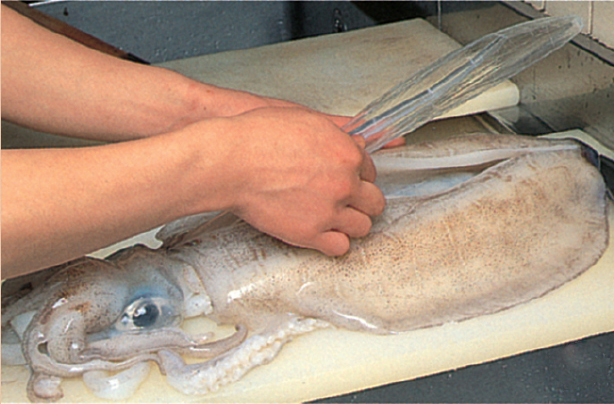
2 Remove cartilage.
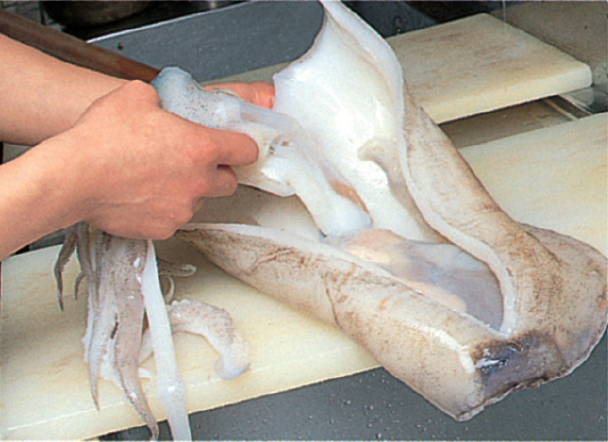
3 Remove innards and take tentacles off mantle.

4 Remove fins and outer skin from mantle.

5 Slice mantle into four pieces vertically.

6 Peel thin skin with wet cloth. The fresher, the easier.

7 Slice fin in half.

8 Cut open root of tentacles (head part). Carve out eyeballs and pull out and remove ink sac and innards.

9 Boil water and deposit tentacles. After it boils again, let tentacles cook for a little less than a minute.
Koika
(small squid)
The same prepping method as sumi ika


Koika from Izumi in Kagoshima Prefecture, 50 g

1 Mantle of warizuke size. Peel thin skin just for what you’ll use right away.

2 The tentacles are small, so boil them in water, not salted water.

Aka gai from Yuriage

1 Insert shucker from hinge.

2 With shucker, take off adductor attached to shell.
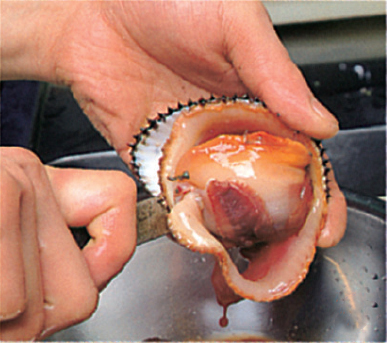
3 Strip flesh.

4 Rinse thoroughly with water.

5 Rinse stripped flesh and slice off strings.

6 Slice off gut attached to string.

7 Trim edge of strings.

8

9 Slice open, trying not to cut off adductor.

10 Cut open flesh horizontally.

11

12 Slice off dark red innards.

13 Trim edge of flesh.

14 Put them in colander and shake and wash with running water.

15 Only five to six stripped in advance, the rest as orders come in.

Miru gai from Cape Irago

1 Open shell with shucker.

2 Take off adductor from shell and remove one side of shell.

3 Separate adductor from other shell so the flesh comes free.

4

5 Slice and sort siphon, adductor, strings, and innards.
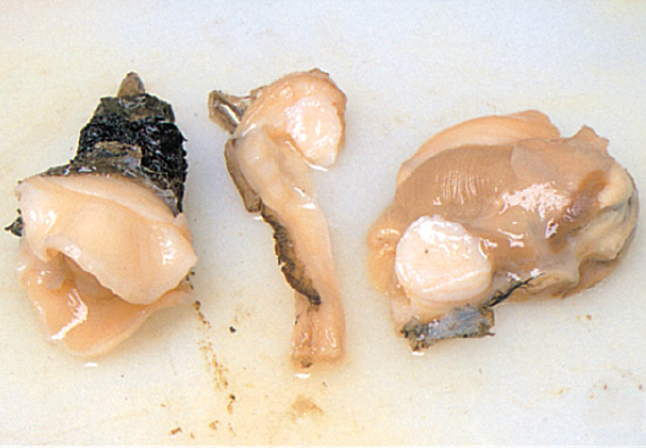
6 From left: siphon, strings, adductor, umbo and innards.

7 Peel off skin on siphon with shucker.

8 Scrape off remaining skin with tip of knife.

9 Slice open siphon.

10 Slice off membrane in siphon.

11 Cut off hard part of siphon at tip.

12 Rinse with water.

13 Six pieces’ worth. Drain water and put in tane box.

Anago from Nojima, 120 to 130 g

1 Placing anago with back facing you, pierce meuchi (rod) above pectoral fin to stabilize.

2 Insert debabocho (broad-bladed kitchen knife) right behind pectoral fin.

3 Slide knife along spine and open back.

4 Firmly press down flesh with left hand following knife’s movement, and cut open to tip of tail.

5 Remove innards. Because it’s fresh, comes out in one go.

6 Insert knife under spine and slice off.

7 Draw knife on flesh to remove muck.

8 Cut off tail and dorsal fin.

9 Remove sinews attached to flesh as well.

10 Draw knife on flesh again to flatten.

11 Cut head off right behind pectoral fin.

13 Change water and massage while washing. Repeat three times.

14 Heat pot with plenty of water and put white granulated sugar in it.

15 Add mirin (sweet rice wine).

16 Add shoyu (soy sauce).

17

18 Once it starts to boil, put anago in it.

19 To avoid having anago dance around, use an otoshibuta (drop-lid).

20 Simmer over medium heat. Remove foam that starts to float up.

21 Each anago makes three to pieces of nigiri and is ready after twenty-five minutes.
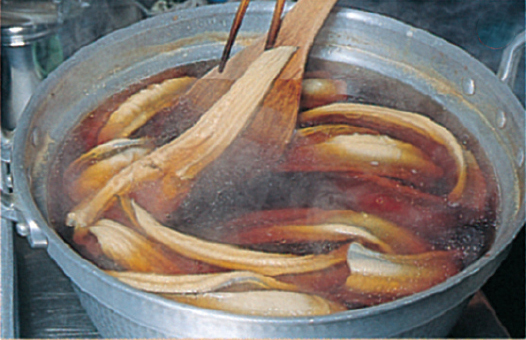
22 The flesh is too soft to be picked up by saibashi (long chopsticks), so scoop with wooden spoon.

23 Arrange flesh-side up on tray, cover with wet cloth, and store at room temperature.

1 Madako, Sajima, 1.5 kg

2 The innards inside the head are removed in the morning at the market, but the remaining flesh moves around vigorously.

3

4 Insert knife by eyes at root of head and carve them out.

5 In washing tub, start massaging as is.

6 Massage with your whole weight. It will feel slimy after ten minutes or so.

7 The live tako starts to go limp.

8 Discard the slime and continue massaging.

9 Previously limp, it swells a little now.

10 Keep massaging away. Don’t wash yet because the skin will come off.

11 The sliminess begins to abate. You can also massage it more easily now.

13 When the tentacles bow out as if squaring shoulders, you’re almost done massaging.

14 Continue massaging, and they slope back a little. Done.

15 Bring a lot of water to boil, and hang tako from a wire and submerge from tip of tentacles.

16 Until tentacles curl outward, dunk in and out of hot water a couple of times.

17 Once tentacles are curled up, sink body in hot water and boil it.

18 Boil over high heat for sixteen minutes. Broth said to be effective for chilblains.

19 Don’t touch with hands or its skin will peel. Hook wire on head, pull out of pot, and let hang.
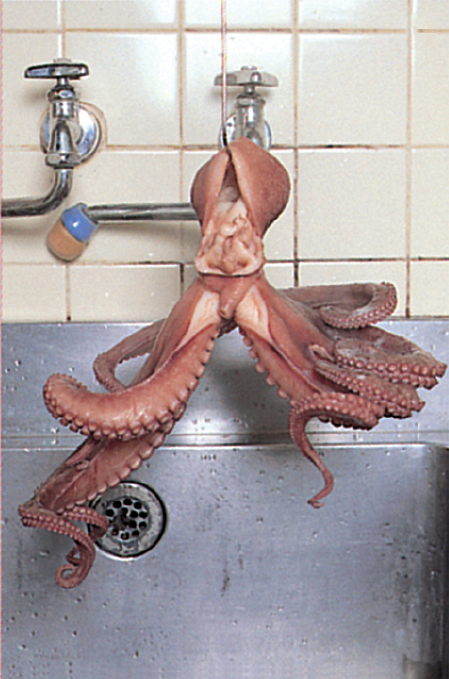
20 Chill at room temperature like so until it’s at body temperature.

Stripped flesh of hamaguri from Ise, 80 to 90 g per with shell

1 Skewer siphons of hamaguri with bamboo stick.

2 In running water, hold and spin bamboo skewer to wash stripped flesh.

3 After removing sand and sliminess, lay on colander to drain.
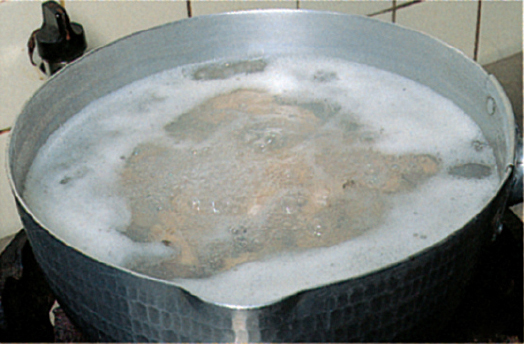
4 Place in boiling water and return to a boil.

5 Lay on colander to cool. Cook to core with the residual heat.
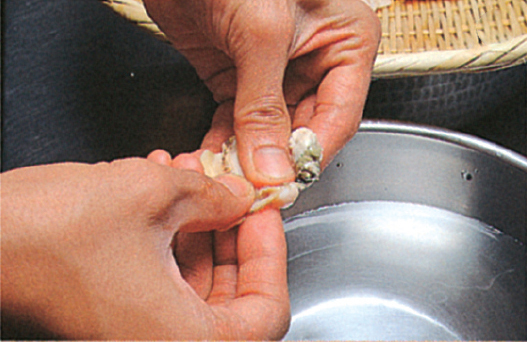
6 Pick up with fingers and push out gut.

7 Remove all sinew as well.

8 Insert knife from leg and open flesh horizontally.

9

10 Hamazume reduction sauce: add sugar, shoyu (soy sauce), and mirin (sweet rice wine) to broth from boiling hamaguri and simmer down.

11 Pile and arrange open hamaguri and pour hamazume over them.

13 Flip and let hamazume penetrate all the way through.

14 Flip them twice or so. The juice also comes out, and it marinates better.

15 Good to eat after a few hours of marinating.
Shako
(mantis shrimp)


Shako with eggs from Koshiba

1 Boil water and add white granulated sugar.

2 Add mirin (sweet rice wine) for a better aftertaste than sake.

3 Add shoyu (soy sauce) and boil to reduce alcohol content.

4 Once boiling, skim the foam.

5 Put shako in it.

6 After returning to a boil, skim the foam and turn off heat.
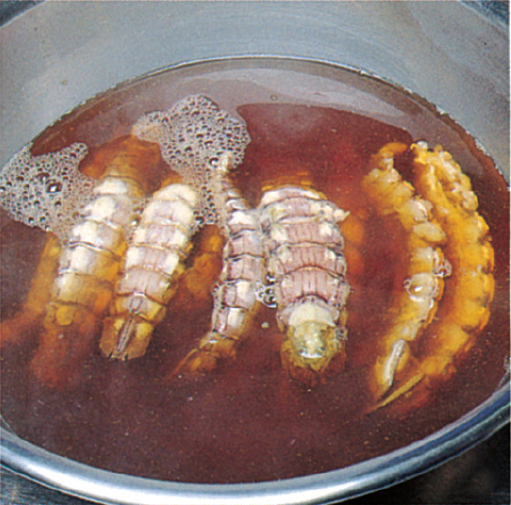
7 Cool to room temperature in broth. When completely cooled, take out of broth, and they’re done.

Awabi, female from Iwawada, 800 g
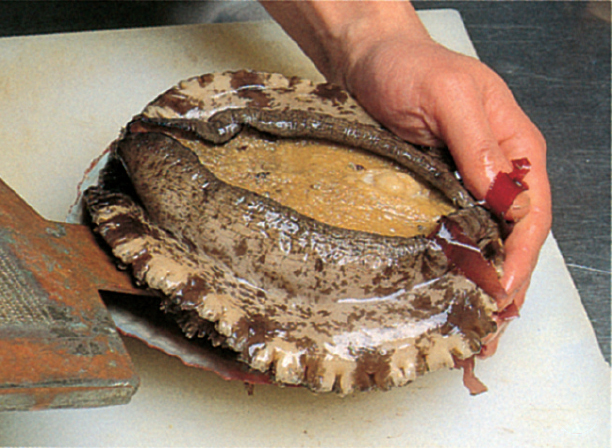
1 Insert handle of grater between shell and flesh and take off adductor.

2

3 Pull out flesh, and forcefully use hand like blade to pry off.

4 Pull out membrane and gut from shell. Simmer gut and make hors d’oeuvres with it.

5 Cut off membrane attached to shell.

6 Remove shell muscle by threshing with base of knife.

7 Scrub flesh with tawashi (scourer) and get rid of dirt and sliminess.

8 Wash away dirt thoroughly on front and in the folds.

9 Put awabi in pot with water, add less sake than the amount of water, and cook over high heat.

10 Skim the foam when it starts to boil.

11 Reduce heat and keep adding water and skimming foam.
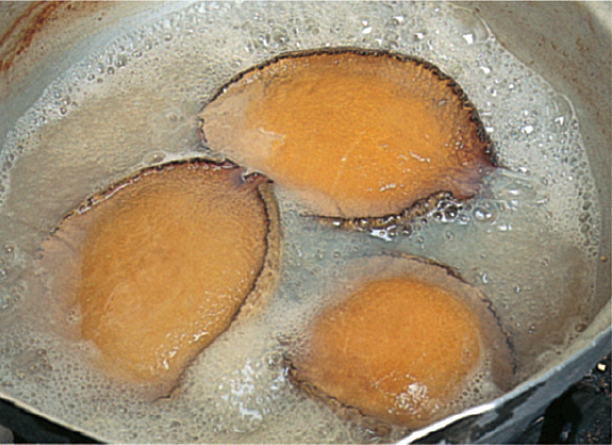
12 Simmer for three to four hours. Done when flesh turns amber-colored.

13 Let cool in broth. The soft ones for nigiri, the harder ones become hors d’oeuvre.

Raw ikura from Sanriku. Select ones with soft skin by tasting.

1 Break the thin outer skin of the skein.

2 Put salt into warm water (slightly hotter than bath).

3 Massage and unravel ikura after placing in water.

4 Wash away dirt and scraps of skin.

5 Add water, hot water, and salt, and continue to massage and unravel it.

6 Remove squashed scraps and hard roe. Repeat until clean.

7 Put in colander and drain in refrigerator.

8 Marinate in mixture of sake, shoyu, and salt that has been boiled and chilled.

9 Taste after a few hours and add more marinade if necessary.

Eggs, shiba ebi (from Mikawa), yamatoimo (Japanese mountain yam), sugar, salt, and mirin.

1 Purée peeled shiba ebi.

2 Place in a mortar, and add grated yamatoimo.

3 Grind well with pestle.

4

5 Add pinch of salt and sugar and keep grinding well.

6 When it gets stickier, adjust with mirin.

7

8 Using two eggs at a time, add in and grind. Repeat.

9

10 Add two eggs yet again and grind, then check. If sticky, add one more egg. Use seven eggs in total.

11 Heat omelette maker or pan and oil.

12 Measure by putting pan close to face. Try not to heat too much.

14 Fill right up to brim and place over minimum heat.

15 It starts to rise after twenty minutes. Insert metal skewers along the edges of the pan.

16 Thirty minutes …

17 Insert two saibashi (long chopsticks) between tamagoyaki and pan, lift up tamagoyaki, and flip.

18 Put pan with flipped tamagoyaki back over slightly higher heat.

19 Put wooden lid on tamagoyaki and press down hard to get rid of bubbles.

20 When tamagoyaki swells further, twist metal skewer into edge.

21 Flip pan upside down and catch tamagoyaki with wooden lid.

22 Touch with belly of your fingers to make sure it’s cooked through.

23 Let cool on bonzaru (wicker colander).

24 Tamagoyaki done. The side grilled first is the front.

1 Strain anago (conger eel) broth.

2 Completely fill pot with water and add white granulated sugar.

3 After it reaches a boil, skim foam. Reduce heat to low after tasting.

4 Simmer down by half—on a low flame, uncovered, from morning to evening.

5 On the next day, pour into smaller pot and put over minimum heat after adding mirin (sweet rice wine).

6 After twelve hours, it’s reduced to a quarter; after seventeen, to an eighth.
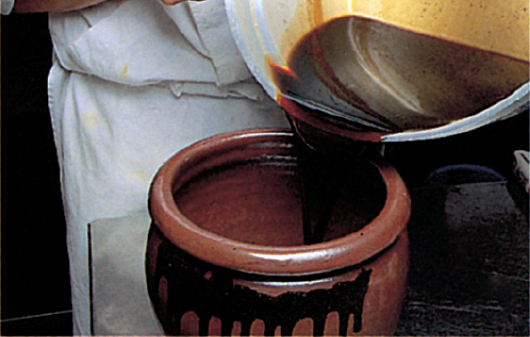
7 Cool finished nitsume, put in jar, and store in refrigerator.
Nikiri
(thin and sweet glaze)

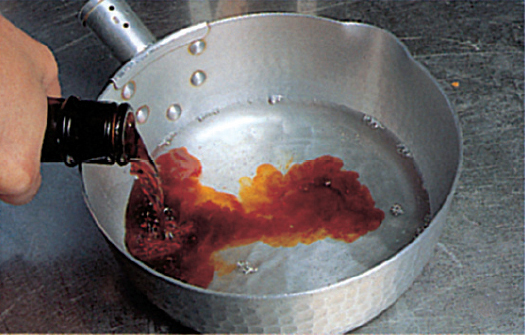
1 Pour sake and shoyu (soy sauce) in pot, add a little mirin (sweet rice wine), and heat.

2 When it starts to boil, flambé it and reduce.

3 Let cool and it’s done.

4 Pour into small bowl and bring to counter.